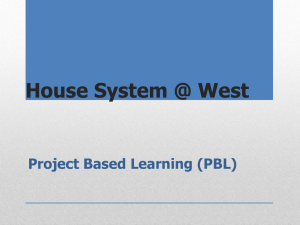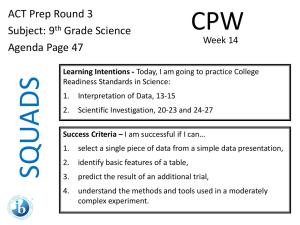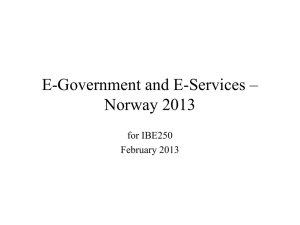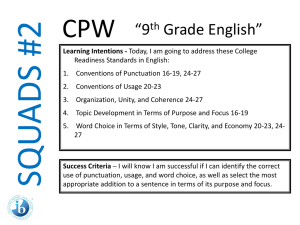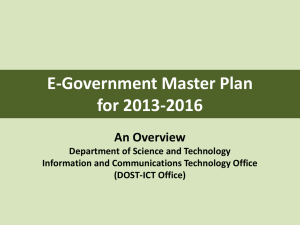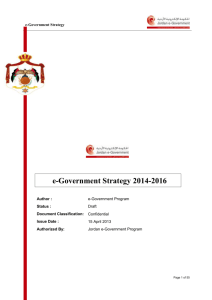E-Government Architecture &Transformation
advertisement
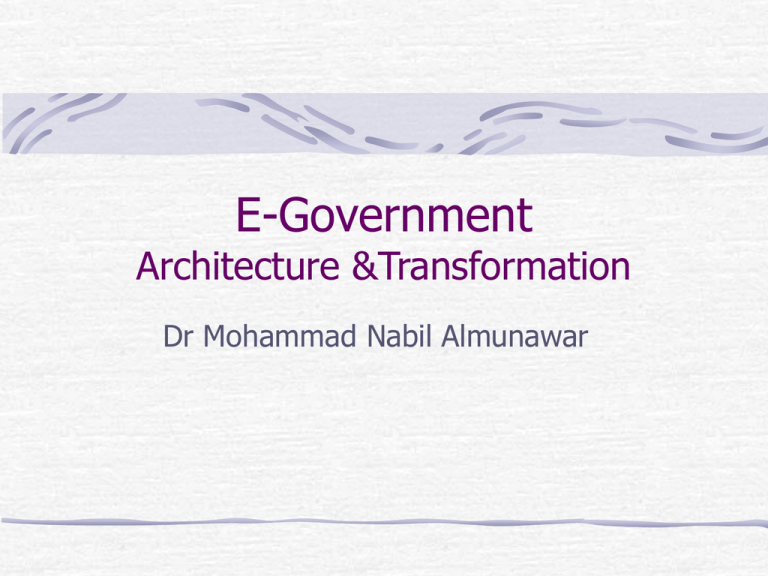
E-Government Architecture &Transformation Dr Mohammad Nabil Almunawar Definitions & Concepts E-government: the use of IT in general, and e-commerce in particular, to provide access to government information and delivery of public services to citizens and business partners. E-government is normally used to conduct government business transactions with citizens and business and within governments themselves. 9th EDPSGO 2005 2 Definitions & Concepts (cont.) E-Commerce defined from these perspectives Communications EC is the delivery of goods, services, information or payments over computer networks or by other electronic means Business process EC is the application of technology towards automation of business transactions and work flow Service EC is a tool that addresses the desire of firms, consumers, and management to cut service costs 9th EDPSGO 2005 3 Government-to-Citizens (G2C): G2C: e-government category that includes all the interactions between a government and its citizens that can take place electronically. Major features of government Web sites (emarketer.com survey): phone and address information(96%), links to other sites(71%), publications(93%), databases(57%) Major areas of G2C activities: tourism and recreation, research and education, downloadable forms, discovery of government services, information about public policy, advice about health and safety issues 9th EDPSGO 2005 4 Government-to-Business (G2B) G2B: e-government category that includes interactions between governments and businesses (government selling to businesses and providing them with services and businesses selling products and services to government) G2B Areas: E-Procurement Reverse E-Auctions Forward E-Auctions Tax Collection and Management 9th EDPSGO 2005 5 Government-to-Government (G2G) and Government-to Employee(G2E) G2G: e-government category that include activities between governments units Collaboration between government units Aggregation of government e-procurement G2E: e-government category that includes activities and services between government units and their employees. Provide services and information to government employees 9th EDPSGO 2005 6 E-Government Architecture In general governments, through different modernization processes and technological implementations, are building a new architecture, based upon the following principles: A unique and shared view of the clients (citizens) with a focus on providing integral, differentiated and customised public services. Governments want to be organised according to what makes more sense to citizens. An active Public Administration, able to foresee and respond in advance to citizens´needs and requirements. An interactive and accessible Public Administration, which centralises contact with the citizen into a single point, via any channel convenient to them (phone, e-mail, web, sms, fax…) 9th EDPSGO 2005 7 E-government architecture (cont.) An Administration that can manage collaborative services: integration must occur not only between public agencies but also with the private sector, which in many cases is providing, by delegation, services of a public nature. A new way for delivering public services: Services oriented to citizens´ requirements and demands. Efficiency and transparency through planning, automated workflows, integrated information, outcome control and cost reduction Improvement of civil servants capabilities (knowledge management) 9th EDPSGO 2005 8 E-Government Architecture (cont.) Other public agencies Civil Servants Companies Individuals Professionals Suppliers Cooperating entities Universal Access through CRM/ E-procurement/ Market place Knowledge Management T A X E S I N D U S T R Y H E A L T H J U S T I C E (...) Management Control Business Intelligence / Business Processes Security Change Management Internet Call center Physical Portable etc. Information Architecture Citizens Database • • • Administrative Record Core Information Systems Human Resources Financial, Budgetary Workflow, doc. Mgt. Legacy ERP Infrastructure: Hardware, Communications Business Process, Infrastructure and Applications Maintenance Project Management Office 9th EDPSGO 2005 9 Implementing E-Government The transformation from traditional delivery of government services to full implementation of online government services may be a lengthy process Transformation process Stage 1: Information publishing/dissemination Stage 2: “Official” two-way transactions with one department at a time Stage 3: Multipurpose portals Stage 4: Portal personalization Stage 5: Clustering of common services Stage 6: Full integration and enterprise transformation 9th EDPSGO 2005 10 Transformation Process Stage 1: Individual government departments set up their own Web sites. These provide the public with information about the departments, the range of services it offers, and contact for further assistance. Stage 2: With the help of legally valid digital signatures and secure Web sites, customers are able to submit personal information to and conduct monetary transactions with government departments 9th EDPSGO 2005 11 Transformation Process (cont.) Stage 3: A portal allows customers to use a single point of entry to send and receive information and to process monetary transactions across multiple departments. Stage 4: government put more power into customer’s hand by allowing them to customize portals with their desired features. To accomplish this governments require much more sophisticated Web programming that permits interfaces to be manipulated by the users. 9th EDPSGO 2005 12 Transformation Process (cont.) Stage 5: this stage is where the real transformation of government structure takes shape. A customer now view once-disparate services as a unified package through the portal, their perception of departments as distinct entities will begin blur. They will recognize groups of transactions rather than groups of agencies. To make this happen, governments will cluster services along common line to accelerated the delivery of shared service (a business restructuring will take place!) Stage 6: this stage offers full-service center, personalized to each customer’s need and preference. Old walls defining silos of government services have been turn down, and technology is integrated across the new structure. 9th EDPSGO 2005 13 9th EDPSGO 2005 14 Implementation issues Transformation speed – speed at which a government moves from stage 1 to stage 6 is very slow G2B implementation – implementation of G2B is easier than implementation of G2C Security and privacy issues – Security and privacy of citizens’ data Wireless applications – some wireless applications are available. Managing changes 9th EDPSGO 2005 15 Citizens adoption of e-government 9th EDPSGO 2005 16

